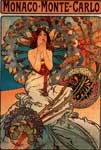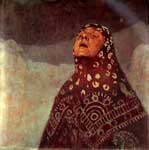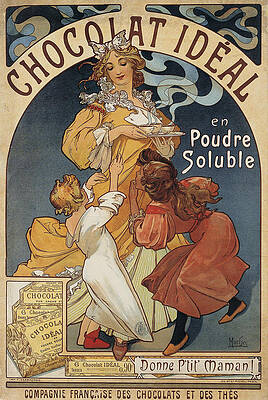Alphonse Maria Mucha
Paintings , Drawings




Bosnian Legends: Murcia - The Plague Lady

Bosnian Legends: Death of Hasanaga's Bride






























Fine Art Prints | Greeting Cards | Phone Cases | Lifestyle | Face Masks | Men's , Women' Apparel | Home Decor | jigsaw puzzles | Notebooks | Tapestries | ...
Alfons Maria Mucha[1][2] (Czech: [ˈalfons ˈmuxa] ( listen); 24 July 1860 – 14 July 1939), often known in English and French as Alphonse Mucha, was a Czech Art Nouveau painter and decorative artist,[3] known best for his distinct style. He produced many paintings, illustrations, advertisements, postcards, and designs.
Early years
Alphonse Maria Mucha was born in the town of Ivančice, Moravia (the present Czech Republic). Although his singing abilities allowed him to continue his education through high school in the Moravian capital of Brno, drawing had been his main hobby since childhood. He worked at decorative painting jobs in Moravia, mostly painting theatrical scenery. In 1879, he relocated to Vienna to work for a major Viennese theatrical design company, while informally augmenting his artistic education. When a fire destroyed his employer's business during 1881 he returned to Moravia, to do freelance decorative and portrait painting. Count Karl Khuen of Mikulov hired Mucha to decorate Hrušovany Emmahof Castle with murals, and was impressed enough that he agreed to sponsor Mucha's formal training at the Munich Academy of Fine Arts.
Mucha moved to Paris in 1887, and continued his studies at Académie Julian and Académie Colarossi. In addition to his studies, he worked at producing magazine and advertising illustrations. About Christmas 1894, Mucha happened to go into a print shop where there was a sudden and unexpected need for a new advertising poster for a play featuring Sarah Bernhardt, the most famous actress in Paris, at the Théâtre de la Renaissance on the Boulevard Saint-Martin. Mucha volunteered to produce a lithographed poster within two weeks, and on 1 January 1895, the advertisement for the play Gismonda by Victorien Sardou was posted in the city, where it attracted much attention.[4] Bernhardt was so satisfied with the success of this first poster that she began a six-year contract with Mucha.
Mucha produced a flurry of paintings, posters, advertisements, and book illustrations, as well as designs for jewelry, carpets, wallpaper, and theatre sets in what was termed initially The Mucha Style but became known as Art Nouveau (French for "new art"). Mucha's works frequently featured beautiful young women in flowing, vaguely Neoclassical-looking robes, often surrounded by lush flowers which sometimes formed halos behind their heads. In contrast with contemporary poster makers he used pale pastel colors.[5]
Mucha's style was given international exposure by the 1900 Universal Exhibition in Paris, of which Mucha said, "I think [the Exposition Universelle] made some contribution toward bringing aesthetic values into arts and crafts."[6] He decorated the Bosnia and Herzegovina Pavilion and collaborated with decorating the Austrian Pavilion. His Art Nouveau style was often imitated. The Art Nouveau style however, was one that Mucha attempted to disassociate himself from throughout his life; he always insisted that rather than maintaining any fashionable stylistic form, his paintings were entirely a product of himself and Czech art.[4] He declared that art existed only to communicate a spiritual message, and nothing more; hence his frustration at the fame he gained by his commercial art, when he most wanted to concentrate on more artistic projects.
Poster design by Mucha for Cycles Perfecta (1902)
Marriage
Mucha married Maruška (Marie/Maria) Chytilová on 10 June 1906, in Prague. The couple visited the U.S. from 1906 to 1910, during which time their daughter, Jaroslava, was born in New York City. They also had a son, Jiří, (born 12 March 1915 in Prague; died 5 April 1991 in Prague) who later became a journalist, writer, screenwriter, author of autobiographical novels and studies of the works of his father. In the U.S., Mucha expected to earn money to fund his nationalistic projects to demonstrate to Czechs that he had not "sold out".[4] He was assisted by millionaire Charles R. Crane, who used his fortune to help promote revolutions and, after meeting Thomas Masaryk, Slavic nationalism. Alphonse and his family returned to the Czech lands and settled in Prague, where he decorated the Theater of Fine Arts, contributed his time and talent to create the murals in the Mayor's Office at the Municipal House, and other landmarks around the city. When Czechoslovakia won its independence after World War I, Mucha designed the new postage stamps, banknotes, and other government documents for the new state.
Le Pater
Mucha considered his publication Le Pater to be his printed masterpiece, and referred to it in the New York Sun of 5 January 1900 as what he had "put [his] soul into it". Printed on 20 December 1899, Le Pater was Mucha's occult examination of the themes of The Lord's Prayer and only 510 copies were produced.[7]
The Slav Epic
Mucha working on The Slav Epic
Main article: The Slav Epic
Study of a seated man, 1891
Mucha spent many years working on what he considered his life's fine art masterpiece, The Slav Epic (Slovanská epopej), a series of twenty huge paintings depicting the history of the Czech and the Slavic people in general, bestowed to the city of Prague in 1928. He had wanted to complete a series such as this, a celebration of Slavic history, since he was young. From 1963 until 2012 the series was on display in the chateau in Moravský Krumlov in the South Moravian Region in the Czech Republic. Since 2012 the series has been on display at the National Gallery's Veletržní Palace.[8]
Death
The rising tide of fascism during the late 1930s resulted in Mucha's works and his Slavic nationalism being denounced in the press as 'reactionary'. When German troops moved into Czechoslovakia during the spring of 1939, Mucha was among the first persons to be arrested by the Gestapo. During his interrogation, the aging artist became ill with pneumonia. Though released eventually, he may have been weakened by this event. He died in Prague on 14 July 1939, due to lung infection, and was interred there in the Vyšehrad cemetery.[3]
Legacy
Although it enjoys great popularity today, at the time when he died, Mucha's style was considered outdated. His son, author Jiří Mucha, devoted much of his life to writing about him and bringing attention to his artwork. In his own country, the new authorities were not interested in Mucha. The Slav Epic was rolled and stored for twenty-five years before being shown in Moravsky Krumlov, and a Mucha museum opened in Prague, managed by his grandson John Mucha.[4]
Mucha's work has continued to experience periodic revivals of interest for illustrators and artists. Interest in Mucha's distinctive style experienced a strong revival during the 1960s (with a general interest in Art Nouveau)[9] and is particularly evident in the psychedelic posters of Hapshash and the Coloured Coat, the collective name for British artists Michael English and Nigel Waymouth, and Bob Masse.[10]
Mucha's work is a strongly acknowledged influence for Stuckist painter Paul Harvey.[11]
The band Soilent Green used a picture by Mucha for the cover art of their album Sewn Mouth Secrets.[12]
One of Mucha's paintings, Quo Vadis or alternately Petronius and Eunice, was the subject of a legal dispute in 1986. The judgment by Richard Posner describes parts of Mucha's life and work biographically.[13]
Among his many other accomplishments, Mucha was also the restorer of Czech Freemasonry.[14]
One of the largest collections of Mucha's works is in the possession of former world no. 1 professional tennis player Ivan Lendl, who started collecting his works upon meeting Jiří Mucha in 1982. His collection was exhibited publicly for the first time in 2013 in Prague.[15]
See also
List of works by Alphonse Mucha
Notes and references
"Mucha, Alphonse", Grove Dictionary of Art Online. Retrieved 3 October 2009.(subscription required)
"New Town", Frommers Eastern Europe, p. 244. Retrieved 8 October 2009.
"Mucha, Noted Artist, Dropped First Name; Death Due To Shock Caused By Germans' Seizure Of Prague.". New York Times. 18 July 1939. Retrieved 20 April 2008. "The artist Mucha—he always signed his work without his given name, which he preferred to ignore—died here ..."(subscription required)
An Introduction to the Work of Alphonse Mucha and Art Nouveau, lecture by Ian Johnston of Malaspina University-College, Nanaimo, BC. This document is in the public domain and may be used by anyone, in whole or in part, without permission and without charge, provided the source is acknowledged
Anna Dvorak. “Illustrations for Books and Periodicals.”, page 134 in Alphonse Mucha: The Complete Graphic Works. Ed. Anne Bridges. NY: Harmony, 1980.
Alphonse Mucha;Documents Decoratifs 1902
The Sun newspaper, 5 January 1900, cited in "Alphonse Mucha". Century Guild Gallery. Archived from the original on 27 August 2013.
Jiřičná, Klára (16 May 2012). "Slav Epic finally on display". The Prague Post. Archived from the original on 29 July 2014.
Fraser, Julie. H. "Recycling art" style2000.com.
Masse, Bob. "Bob Masse's 60's Rock and Roll Art and Concert Posters" Retrieved April 2011.
Milner, Frank ed. The Stuckists Punk Victorian, p.74, National Museums Liverpool, 2004. ISBN 1-902700-27-9
"Soilent Green". Metal Blade Records. Archived from the original on 15 March 2008. Retrieved 3 March 2008.
"Project Posner". Project Posner. Retrieved 25 January 2011.
"Tajné společenství v Čechách – zednáři" [Secret society in the Czech Republic - Freemasons] (in Czech). ČT24. 30 December 2009. Retrieved 25 January 2011.
Ivan Lendl: Alphonse Mucha, retrieved 16 July 2014.
----
Fine Art Prints | Greeting Cards | Phone Cases | Lifestyle | Face Masks | Men's , Women' Apparel | Home Decor | jigsaw puzzles | Notebooks | Tapestries | ...
----
Artist
A - B - C - D - E - F - G - H - I - J - K - L - M -
N - O - P - Q - R - S - T - U - V - W - X - Y - Z
Retrieved from "http://en.wikipedia.org/"
All text is available under the terms of the GNU Free Documentation License



